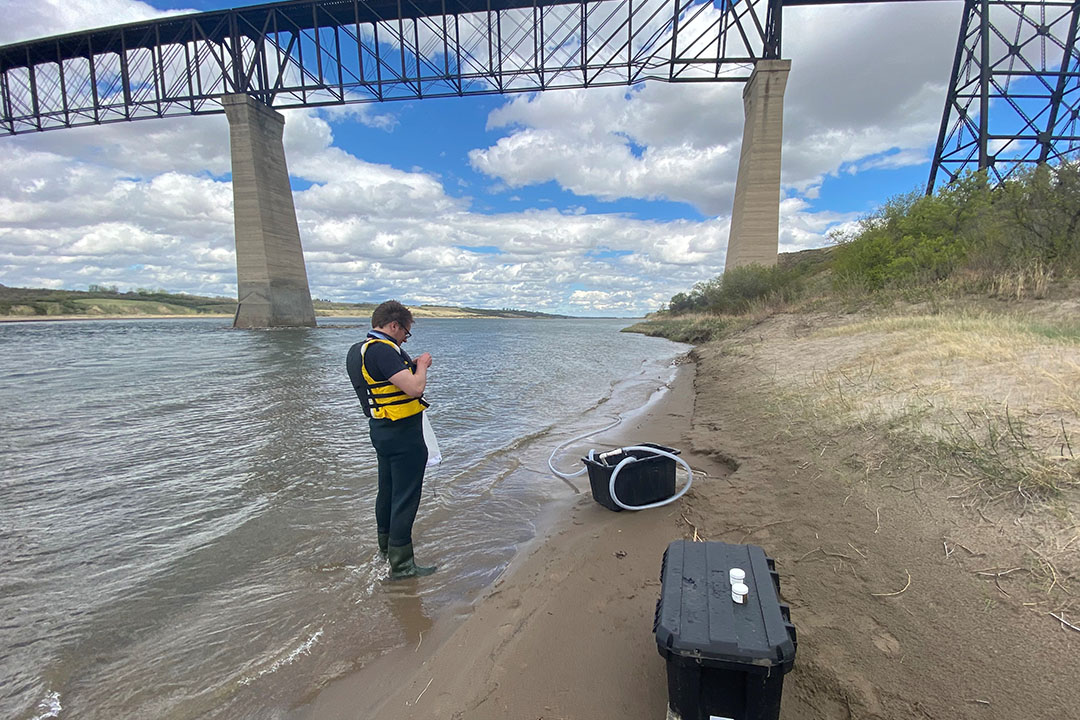
SENS researcher studying microplastics in surface water
How big of a problem is the issue of microplastics in our surface water?
By Megan EvansUniversity of Saskatchewan (USask) researcher Dr. Markus Brinkmann (PhD) is determined to find out.
“Most of our food today contains some small amount of plastic,” said Brinkmann, an assistant professor at USask’s School of Environment and Sustainability (SENS). “Whether it’s from yogurt cups or synthetic tea bags, there is some plastic in human food and potentially even in our water supply.”

In one of a number of water quality research projects he is working on, Brinkmann has partnered with the South Saskatchewan River Watershed Stewards (SSRWS)—a non-governmental organization focused on initiatives that help educate people about water quality and the impact of our actions on the environment—and the City of Saskatoon to determine levels of microplastics that are draining into local river systems.
Kerry Lowndes, watershed co-ordinator with SSRWS, understands that making environmentally friendly consumer choices can be difficult. Lowndes said the convenience of using plastics in society has created a new environmental challenge.
“This project has been invaluable, because if there is one thing I want people to take away here, it’s for people to put microplastics on their radar,” Lowndes said. “Microplastics from recycled and synthetic materials can end up in our water supply through the washing machine and then you find out you could be part of making the problem even bigger. Once we know what the problem is, we can manage it. We can’t fix what we can’t see.”
Brinkmann suspects that any side-effects suffered by humans ingesting plastic are minimal compared to the consequences of these microplastics and fibres ending up in wildlife populations.
“Microbeads, which were widely used in cosmetics and personal care products, are now banned in Canada. But for exposed animals, microbeads might not have been the biggest problem, as they are shaped in such a way that they might more easily pass through an animal’s digestive tract,” he said. “Synthetic fibres and smaller debris particles might put animals at risk of clogging, tearing, or rupturing their intestinal tracts. This is especially true as you move up the food chain, where larger animals are processing larger volumes of these unnatural particles and fibres.”
Microplastics can also wind up in the agricultural supply since the sludge from many wastewater treatment plants is used as fertilizer. There are few studies into the potential transfer into the human food supply, and the associated risks are poorly understood.
“What are the risks or side-effects of this? That is an important area for future study, because we are not sure. This is currently an environmental hygiene issue,” Brinkmann said. “We are just beginning to understand how widespread this problem is. We have to make sure that if we’re using plastics, we do it properly.”
Brinkmann’s project partner is Dr. Tara Kahan (PhD), associate professor and Canada Research Chair in Environmental Analytical Chemistry at USask, whose research group is analyzing the chemical composition of the microplastics to help determine whether the toxicity depends on where they come from.
“Interdisciplinary collaborations can be very powerful when faced with complex environmental issues such as this one,” Kahan said. “Combining physical characterization of microplastics with toxicological studies and chemical analysis will help us understand the risks microplastics pose to environmental health in Saskatchewan.”
Brinkmann’s previous toxicology research has ranged from studying levels of pharmaceuticals washed into surface water to determining whether COVID-19 can be detected in sewage samples. This new project will allow the City of Saskatoon to consider what adjustments need to be made, and for the watershed stewards to continue their public education campaign regarding harmful microplastics. With more funding, Brinkmann hopes to extend this research to gain a better understanding of the risks to wildlife.
At this point, sampling has been limited to water from the South Saskatchewan River and storm ponds within Saskatoon. In the future, Brinkmann plans to also sample mussels and fish to understand the potential impacts of microplastics on those groups.
“The City of Saskatoon is pleased to support this project through our Environmental Grants Program, especially because of the collaboration between local organizations involved,” said Katie Burns, manager of community leadership and program development for the City of Saskatoon. “The Government of Canada is currently engaging on an integrated management approach to plastic products, which identifies roles for all levels of government, plastic producers, recyclers, and residents in achieving zero plastic waste and eliminating plastic pollution.
“The City of Saskatoon is participating because knowing the extent of microplastics in our watershed and educating residents about the effects of microplastic pollution will help set the stage in our community for upcoming new initiatives from the federal government, such as banning or restricting certain single-use plastics or new end-of-life programs where companies are responsible for the collection and recycling of plastic products they manufacture, import or sell.”
Article re-posted on .
View original article.

